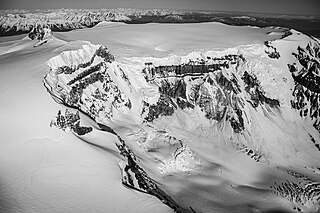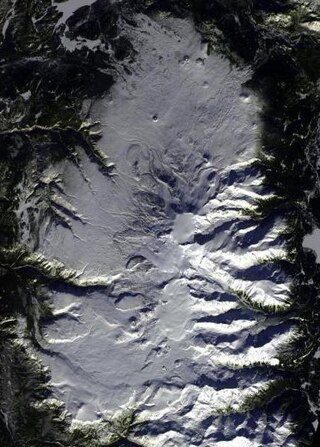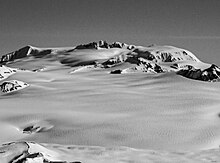
Mount Edziza, sometimes called Edziza Mountain or Edziza Peak, is a stratovolcano in Cassiar Land District of northwestern British Columbia, Canada. It is located on the Big Raven Plateau of the Tahltan Highland which extends along the western side of the Stikine Plateau. The mountain has an elevation of 2,786 metres, making it the highest volcano of the Mount Edziza volcanic complex. However, it had an elevation of at least 3,396 metres before its original summit was likely destroyed by a violent, climactic eruption in the geologic past; its current flat summit contains an ice-filled, 2-kilometre (1.2-mile) in diameter crater. Mount Edziza contains several lava domes, cinder cones and lava fields on its flanks, as well as an ice cap that is characterized by several outlet glaciers stretching out to lower altitudes. All sides of the mountain are drained by tributaries of Mess Creek and Kakiddi Creek which are situated within the Stikine River watershed.

Tennena Cone, alternatively Icebridge Cone, is a small volcanic cone in Cassiar Land District of northwestern British Columbia, Canada. It has an elevation of 2,390 metres and lies on the western flank of Ice Peak, the prominent south peak of Mount Edziza. The cone is almost completely surrounded by glacial ice of Mount Edziza's ice cap which covers an area of around 70 square kilometres. Tennena Cone is 200 metres high, 1,200 metres long and up to 600 metres wide, its symmetrical structure resembling a black pyramid. The cone and the surrounding area are in Mount Edziza Provincial Park which also includes the Spectrum Range to the south.
The Sheep Track Member is a stratigraphic unit of the Big Raven Formation, part of the Mount Edziza volcanic complex in northwestern British Columbia, Canada. It consists of pumice from an explosive eruption that fell over an area about 40 square kilometres. The pumice is of comenditic trachyte composition and reaches a thickness of up to 2 metres along the western edge of Tencho Glacier.

The Mount Edziza volcanic complex is a group of volcanoes and associated lava flows in northwestern British Columbia, Canada. Located on the Tahltan Highland, it is 40 kilometres southeast of Telegraph Creek and 85 kilometres southwest of Dease Lake. The complex encompasses a broad, steep-sided lava plateau that extends over 1,000 square kilometres. Its highest summit is 2,786 metres in elevation, making the MEVC the highest of four large complexes in an extensive north–south trending volcanic region. It is obscured by an ice cap characterized by several outlet glaciers that stretch out to lower altitudes.
Cartoona Ridge is a mountain ridge extending east from the eastern side of the Mount Edziza volcanic complex in northwestern British Columbia, Canada. It is bounded on the north by Shaman Creek valley, on the south by Chakima Creek valley, on the east by Kakiddi Creek valley and on the west by the Big Raven Plateau. Its highest point and only named peak is Cartoona Peak at the westernmost end of the ridge with an elevation of 2,300 metres. Carttona Ridge is one of three ridges east of the Big Raven Plateau named by Canadian volcanologist Jack Souther, the other two being Idiji Ridge and Sorcery Ridge to the north.

The volcanic history of the Northern Cordilleran Volcanic Province presents a record of volcanic activity in northwestern British Columbia, central Yukon and the U.S. state of easternmost Alaska. The volcanic activity lies in the northern part of the Western Cordillera of the Pacific Northwest region of North America. Extensional cracking of the North American Plate in this part of North America has existed for millions of years. Continuation of this continental rifting has fed scores of volcanoes throughout the Northern Cordilleran Volcanic Province over at least the past 20 million years and occasionally continued into geologically recent times.

The Big Raven Formation is a stratigraphic unit of Quaternary age in northwestern British Columbia, Canada. It is the youngest and least voluminous geological formation of the Mount Edziza volcanic complex (MEVC); it overlies at least six older formations of this volcanic complex. The main volcanic rocks of the Big Raven Formation are alkali basalts and hawaiites, although a small volume of trachyte comprises the Sheep Track Member. These rocks were deposited by volcanic eruptions in the last 20,000 years during the latest magmatic cycle of the MEVC. Alkali basalt and hawaiite are in the form of lava flows and small volcanic cones while trachyte of the Sheep Track Member is mainly in the form of volcanic ejecta which covers an area of about 40 square kilometres.
The Klastline Formation is a stratigraphic unit of Pleistocene age in northwestern British Columbia, Canada.
Kakiddi Creek is a tributary of the Klastline River in northwest part of the province of British Columbia, Canada. It flows north about 35 km (22 mi) through two lakes in a broad hummocky lowland to join the Klastline River, which in turn is a tributary of the Stikine River. Kakiddi Creek forms the northeastern boundary of Mount Edziza Provincial Park which lies within the traditional territory of the Tahltan people.
Tennaya Creek is a tributary of Kakiddi Creek, which in turn is a tributary of the Klastline River, part of the Stikine River watershed in northwest part of the province of British Columbia, Canada. It flows generally west for about 16 km (9.9 mi) to join Kakiddi Creek about 19 km (12 mi) south of Kakiddi Creek's confluence with the Klastline River. Tennaya Creek's watershed covers 63.3 km2 (24.4 sq mi) and its mean annual discharge is estimated at 1.50 m3/s (53 cu ft/s). The mouth of Tennaya Creek is located about 48 km (30 mi) southeast of Telegraph Creek, about 30 km (19 mi) southwest of Iskut and about 86 km (53 mi) south-southwest of Dease Lake. Tennaya Creek's watershed's land cover is classified as 31.3% barren, 26.0% conifer forest, 17.9% snow/glacier, 12.6% herbaceous, 9.9% shrubland, and small amounts of other cover.
Tenchen Creek is a tributary of Kakiddi Creek, which in turn is a tributary of the Klastline River, part of the Stikine River watershed in northwest part of the province of British Columbia, Canada. It flows generally flows northeast for about 8 km (5.0 mi) to join Kakiddi Creek about 13 km (8.1 mi) south of Kakiddi Creek's confluence with the Klastline River. Tenchen is a combination of the Tahltan words "ten" and "chen", which mean "ice" and "dirty" respectively.
Tsecha Creek is a tributary of Kakiddi Creek, which in turn is a tributary of the Klastline River, part of the Stikine River watershed in northwest part of the province of British Columbia, Canada. It flows generally west for about 16 km (9.9 mi) to join Kakiddi Creek about 5 km (3.1 mi) south of Kakiddi Creek's confluence with the Klastline River. Tsecha Creek's watershed covers 23.1 km2 (8.9 sq mi) and its mean annual discharge is estimated at 0.423 m3/s (14.9 cu ft/s). The mouth of Tsecha Creek is located about 44 km (27 mi) east-southeast of Telegraph Creek, about 26 km (16 mi) west of Iskut and about 73 km (45 mi) south-southwest of Dease Lake. Tsecha Creek's watershed's land cover is classified as 47.8% barren, 27.5% conifer forest, 13.1% shrubland, 10.3% snow/glacier, and small amounts of other cover.

The Mount Edziza volcanic complex (MEVC) in British Columbia, Canada, has a long history of volcanism that spans more than 7 million years. It occurred during five cycles of magmatic activity, each having produced less volcanic material than the previous one. Volcanism during these cycles has created several types of volcanoes, including cinder cones, stratovolcanoes, subglacial volcanoes, shield volcanoes and lava domes. The approximately 1,000-square-kilometre (400-square-mile) volcanic plateau forming the base of the MEVC owes its origin to successive eruptions of highly mobile lava flows. Volcanic rocks such as basalt, trachybasalt, benmoreite, tristanite, mugearite, trachyte and rhyolite were deposited by multiple eruptions of the MEVC; the latter seven rock types are products of varying degrees of magmatic differentiation in underground magma reservoirs. At least 10 distinct flows of obsidian were produced by volcanism of the MEVC, some of which were exploited by indigenous peoples in prehistoric times to make tools and weaponry. Renewed volcanism could produce explosive eruptions and block local streams with lava flows.

Tencho Glacier is a mountain glacier in northwestern British Columbia, Canada. It is located inside Mount Edziza Provincial Park on the Tahltan Highland, an upland area of the Stikine Plateau. Tencho Glacier is the source of several small streams that flow from the Mount Edziza volcanic complex.
Tenchen Glacier is located on the eastern flank of Mount Edziza in northwestern British Columbia, Canada. It lies within an immense cirque whose headwall has breached the eastern side of Mount Edziza's summit crater. At the head of Tenchen Glacier are icefalls that drape down shear, 300-metre-high (980-foot) cliffs from the breached eastern crater rim; permanent ice fills the summit crater. Meltwater from Tenchen Glacier feeds Tenchen Creek which eventually merges with Kakiddi Creek.
Tennaya Glacier is one of several glaciers draining the eastern side of the Mount Edziza ice cap in northwestern British Columbia, Canada. It is located southeast of the summit of Mount Edziza and northwest of Ice Peak at the head of Tennaya Creek. Meltwater from Tennaya Glacier feeds Tennaya Creek which eventually flows into Nuttlude Lake, an expansion of Kakiddi Creek.
Idiji Glacier is one of several glaciers draining the eastern side of the Mount Edziza ice cap in northwestern British Columbia, Canada. It is located south of the summit of Mount Edziza in a cirque just southeast of Ice Peak. Idiji Glacier is separated from the much larger Tencho Glacier by a ridge that extends south of Ice Peak above the Idiji cirque headwall. Idiji Glacier is the namesake of Idiji Ridge which is just to the southeast.
Artifact Ridge is a mountain ridge extending southeast from the eastern side of the Mount Edziza volcanic complex in northwestern British Columbia, Canada. It is bounded on the north by Bourgeaux Creek valley, on the south by Artifact Creek valley, on the east by the Little Iskut River valley and on the west by the Kitsu Plateau. The ridge is at the southeastern end of Mount Edziza Provincial Park and gets its name from the knapping of obsidian tools and points by early Tahltan hunters. Destell Pass cuts north–south through the westernmost end of Artifact Ridge.
Yagi Ridge is a mountain ridge extending northwest from the middle of the Spectrum Range at the southern end of the Mount Edziza volcanic complex in northwestern British Columbia, Canada. It is bounded on the north by Nagha Glacier and Nagha Creek valley, on the south by Yeda Creek on the Arctic Lake Plateau and on the west by Mess Creek valley. Yagi Ridge reaches an elevation of 2,243 metres at the head of Nagha Glacier where its eastern end adjoins to the Spectrum Range just northwest of Yeda Peak.
Idiji Ridge is a mountain ridge extending east of Tencho Glacier on the southern flank of Mount Edziza in northwestern British Columbia, Canada. It is bounded on the south by a valley containing an unnamed valley, on the east by Tennaya Creek valley and on the north by cirques extending east of Ice Peak. Idiji Ridge takes its name from the adjacent Idiji Glacier; Idiji means "it thunders" in the Tahltan language.











